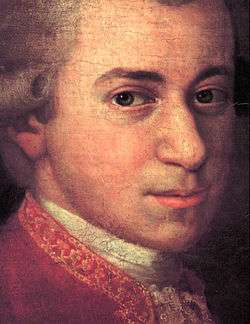Symphony No. 39 (Mozart)
The Symphony No. 39 in E-flat major of Wolfgang Amadeus Mozart, K. 543, was completed on 26 June 1788.[1]
Composition and premiere
The Symphony No. 39 is the first of a set of three (his last symphonies) that Mozart composed in rapid succession during the summer of 1788. No. 40 was completed 25 July and No. 41 on 10 August.[1] Nikolaus Harnoncourt argues that Mozart composed the three symphonies as a unified work, pointing, among other things, to the fact that the Symphony No. 39 has a grand introduction (in the manner of an overture) but no coda.[2]
Around the time that he composed the three symphonies, Mozart was writing his piano trios in E and C major (K. 542 and K. 548), his sonata facile (K. 545), and a violin sonatina (K. 547). Mozart biographer Alfred Einstein has suggested that Mozart took Michael Haydn's Symphony No. 26, in the same key, as a model.[3]
It seems to be impossible to determine the date of the premiere of the 39th Symphony on the basis of currently available evidence; in fact, it cannot be established whether the symphony was ever performed in the composer's lifetime. According to Deutsch (1965), around the time Mozart wrote the work, he was preparing to hold a series of "Concerts in the Casino", in a new casino in the Spiegelgasse owned by Philipp Otto. Mozart even sent a pair of tickets for this series to his friend Michael von Puchberg. But it seems impossible to determine whether the concert series was held, or was cancelled for lack of interest.[1] In addition, in the period up to the end of his life, Mozart participated in various other concerts the programs of which included an unidentified symphony; these also could have been the occasion of the premiere of the 39th (for details, see Symphony No. 40 (Mozart)).
In modern times, the work is part of the core symphonic repertoire and is frequently performed and recorded.
Instrumentation and movements
The symphony is scored for flute, pairs of clarinets, bassoons, horns and trumpets, timpani and strings.
There are four movements:
- Adagio, cut time[4] – Allegro, 3/4 (in sonata form)
- Andante con moto in A-flat major, 2/4 (in modified sonata form without development)
- Menuetto (Allegretto) - Trio, 3/4 (in compound ternary form)
- Allegro, 2/4 (in sonata form)
The first movement opens with a majestic introduction with fanfares heard in the brass section. This is followed by an Allegro in sonata form, though while several features – the loud outburst following the soft opening, for instance – connect it with the galant school that influences the earliest of his symphonies. The independence of the winds and greater interplay of the parts in general, and the fact that the second theme group in those earlier symphonies was (to paraphrase Alfred Einstein) practically always completely trivial, which is not the case here, combine with the second group which contains several themes, including a particularly felicitous "walking theme". These are just a very few of the points that distinguish this movement from those works, from which it has more differences than similarities.
The slow movement, in abridged sonata form, i.e. no development section,[5] starts quietly in the strings and expands into the rest of the orchestra. Quiet main material and energetic, somewhat agitated transitions characterize this movement. The key is A-flat major, the subdominant of E-flat major.
The work has a very interesting minuet and trio. The trio is an Austrian folk dance called a "ländler" and features a clarinet solo. The forceful Menuetto is set off by the trio's unusual tint of the second clarinet playing arpeggios in its low (chalumeau) register. The melody for this particular folk dance derived from local drinking songs which were popular in Vienna during the late 18th century.
The finale is another sonata form whose main theme, like that of the later string quintet in D, is mostly a scale, here ascending and descending. The development section is dramatic; there is no coda, but both the exposition, and the development through the end of the recapitulation, are requested to be, and often are, repeated.
References
Notes
- 1 2 3 Deutsch 1965, 320
- ↑ Clements, Andrew (23 July 2014). "Mozart: The Last Symphonies review – a thrilling journey through a tantalising new theory". The Guardian.
- ↑ "But, as regards the E-flat Symphony [K. 543], it was probably the beginning of a symphony by Michael of 14 August 1783—Mozart was then in Salzburg and may have become acquainted with the work—that supplied the stimulus for the first Allegro: Ex. 7 [four bars of music are quoted in piano reduction] Similarly with the Adagio affettuoso of the Haydn work and Mozart's Andante." (Einstein 1945, 127)
- ↑ Older scores show the introduction in 4/4. See the Neue Mozart-Ausgabe for verification of the cut time marking.
- ↑ http://hem.bredband.net/urigonzalez/treitler_imagination_chapter7.htm
Sources
- Deutsch, Otto Erich (1965) Mozart: A Documentary Biography. Stanford: Stanford University Press.
- Einstein, Alfred (1945) Mozart: His Character, His Work, translated into English by Arthur Mendel & Nathan Broder. Oxford: Oxford University Press.
External links
- Sinfonie in E-flat KV 543: Score and critical report (German) in the Neue Mozart-Ausgabe
- Symphony No. 39: Scores at the International Music Score Library Project
- The apartment where Mozart wrote his last three Symphonies: Michael Lorenz, "Mozart's Apartment on the Alsergrund" Article online
